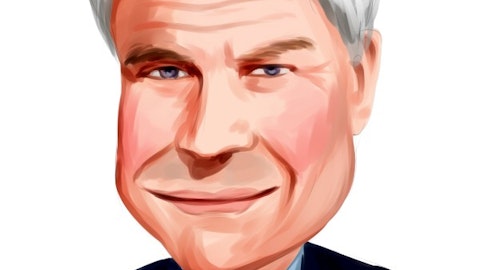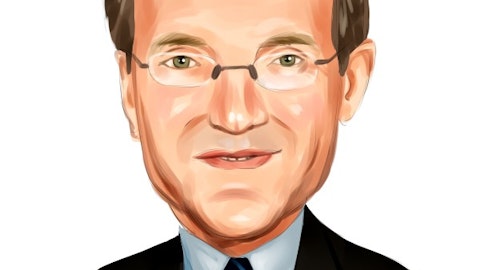PRA Group, Inc. (NASDAQ:PRAA) Q4 2023 Earnings Call Transcript February 15, 2024
PRA Group, Inc. beats earnings expectations. Reported EPS is $-0.22, expectations were $-0.35. PRAA isn’t one of the 30 most popular stocks among hedge funds at the end of the third quarter (see the details here).
Operator: Good evening and welcome to PRA Group’s Fourth Quarter and Full Year 2023 Conference Call. All participants will be in a listen-only mode. After today’s presentation, there will be an opportunity to ask questions. [Operator Instructions] Please note this event is being recorded. I would now like to turn the conference over to Mr. Najim Mostamand, Vice President of Investor Relations for PRA Group. Please go ahead.
Najim Mostamand: Thank you. Good evening, everyone, and thank you for joining us. With me today are Vik Atal, President and Chief Executive Officer; and Rakesh Sehgal, Executive Vice President and Chief Financial Officer. We will make forward-looking statements during the call, which are based on management’s current beliefs, projections, assumptions and expectations. We assume no obligation to revise or update these statements. We caution listeners that these forward-looking statements are subject to risks, uncertainties, assumptions and other factors that could cause our actual results to differ materially from our expectations. Please refer to the earnings press release and our SEC filings for a detailed discussion of these factors.
The earnings release, the slide presentation that we will use during today’s call and our SEC filings can all be found in the Investor Relations section of our website at www.pragroup.com. Additionally, a replay of this call will be available shortly after its conclusion, and the replay dial-in information is included in the earnings press release. All comparisons mentioned today will be between Q4 2023 and Q4 2022, unless otherwise noted, and our Americas results include Australia. During our call, we will discuss adjusted EBITDA and debt-to-adjusted EBITDA for the 12 months ended December 31, 2023, and December 31, 2022. Please refer to today’s earnings release and the appendix of the slide presentation used during this call for a reconciliation of the most directly comparable U.S GAAP financial measures to these non-GAAP financial measures.
And with that, I’d now like to turn the call over to Vik Atal, our President and Chief Executive Officer.
Vikram Atal: Thank you, Najim, and thank you everyone for joining us this evening. At the start, I want to spend a moment thanking each and everyone of our team members for their hard work, sacrifice and dedication through a challenging year. I could not be proud of their contributions. As we move into the new year, it is of course necessary that we look back at our performance in 2023. Equally if not more importantly, it is an opportune time for us to share our prospectives and expectations with regard to our future performance. Our disappointing loss in the first quarter of 2023 largely due to underperformance in our U.S business, crystallize our incentives through the balance of last year. First, stabilize performance and in parallel drive the turnaround.
It’s worth reminding everyone that I assume the position as the CEO in late March 2023. And that during the year, we experience significant changes to the vast majority of our policy and strategy making C-suite team. In rebinding my senior team in whom I’ve the highest confidence, I have concentrated on returning a keen sense of urgency, operational excellence, team work and shareholder alignment through our collective focus. Furthermore, senior leaders and employees of the company have stepped up with significant roles as we realign responsibilities. Together we’ve identified and make substantial progress since April 2023, on numerous important areas of operations where gaps in strategy and performance had developed. I will cover some of this in greater details later on the call.
A few of these changes have involved complex process or organizational redesign, which have taken some time to properly implement and whose financial results are expected to flow through commencing in 2024. As Rakesh will outline in a moment, our financial performance for the fourth quarter and full year of 2023 underscores the progress we made to stabilize performance. Following these remarks, I will provide details regarding the scope, pacing, and progress of our turnaround and the associated financial expectations. With that, it’s over to Rakesh.
Rakesh Sehgal: Thanks, Vik. At a micro level, during 2023, we integrated our management team globally, grew our business with additional portfolio investments, had our debt rating affirmed and made tangible progress on our cash generating and operational initiatives, while controlling our expenses. Turning now to our fourth quarter results, starting with portfolio purchases. We purchased $285 million of portfolios during the quarter, consistent with the prior year period. For the full year, we purchased $1.2 billion of portfolios, up 36% year-over-year. This full year volume represents the third highest level in company history, and it’s particularly encouraging when you consider these investments are being achieved at improved prices and expected returns compared to the 2020 to 2022 time period, which was marked by low supply in the U.S and tight pricing globally.
In the Americas, we invested $162 million in the quarter, up 27% year-over-year. In the U.S., we deployed $141 million, which was up 61% year-over-year. This reflected our strongest Q4 investment level in the U.S in the last 5 years. The improved pricing is demonstrated by the purchase price multiple in our 2023 Americas core vintage, which was initially recorded at 1.75x at the end of the first quarter, but ended the year at 1.97x. Moving to Europe. We invested $123 million across multiple markets during the quarter, demonstrating the diversification of our European business. This amount was up sequentially, but lower when compared to Q4 of last year, driven by fewer large spot transactions coming to market than what we would typically see in Q4.
Moving on to our financial results. Total revenues were $221 million for the quarter and $803 million for the year. Total portfolio revenue for the quarter was $217 million with portfolio income of $195 million and changes and expected recoveries of $23 million. As a reminder, portfolio income is the yield component of our revenue. You can see on the chart on the left that the fourth quarter represented the second quarter in a row that portfolio income has grown year-over-year. We expect this growth in portfolio income to continue reflecting not only purchases and pricing changes that have already taken place, but also new projected investments that are expected to grow the portfolio. Turning to the chart on the right. In addition to portfolio income, our revenues include changes in expected recoveries, which encompasses a combination of cash overperformance or underperformance in the current period, and the net present value of expected changes in our ERC.
To the extent that the operational initiatives that are underway create incremental value, such benefit would flow through our P&L as changes in expected recoveries. During the quarter, we collected $80 million in excess of our expected recoveries, exceeding our expectations on a consolidated basis by 3% with the Americas overperforming by 1% and Europe overperforming by 6%. Operating expenses for the quarter were $176 million, which was up 8% compared to the prior year period. This increase was largely driven by legal collection costs, agency fees, and communication expenses, which importantly, are all linked to growth in our portfolio. Cash efficiency was 57.3% for the fourth quarter. Legal collection costs were $23 million for the quarter, which were up $4 million from the prior year period, driven by a higher volume of accounts flowing into the legal channel from underlying portfolio growth in 2023.
As a reminder, there is a timing lag when we invest in our legal channel. Typically, there is an upfront cost fees to the court when a lawsuit is filed, which is then followed several months later by cash collections starting to build. Agency fees, which are variable and largely driven by cash collections in Brazil were up $4 million this quarter as we continue to experience strong cash collections growth in that market. Communication expenses were up $3 million this quarter, primarily due to expanded business volumes. Net interest expense for the fourth quarter was $51 million, an increase of $16 million reflecting higher debt balances and increased interest rates. We recorded a tax benefit of $16 million in 2023. We expect our effective tax rate to be in the low 20% range for 2024 depending on income mix and other factors.
Net loss attributable to PRA was $9 million, or negative $0.22 in diluted earnings per share. For the full year, net loss attributable to PRA was $83 million, or negative $2.13 in diluted earnings per share. Cash collections for the quarter were $410 million, up 5% from the prior year period, and up 2% on a constant currency basis. For the quarter, Americas cash collections increased 5% or 4% on a constant currency basis, driven primarily by higher collections in Brazil. U.S cash collections decreased 5% for the quarter, largely as a result of lower yields and purchase price multiples from the 2020 to 2022 vintages as the older higher yielding vintages rolled off. This impact should gradually reverse as a result of higher multiples and volumes we recorded in 2023 and the early part of 2024.
European cash collections for the quarter increased 5% or roughly flat on a constant currency basis. Our 2023 cash performance versus our expectations at December 31, 2022 experienced 6% overperformance in Europe, and 3% underperformance in the Americas, or 1% overperformance on a consolidated basis. With regard to pressures on the consumer, we have mentioned last quarter that the cost of living in certain European markets has been having an impact. We continue to see this dynamic resulting in fewer, large one-time payments, although the proportion of customers paying us has remained stable. Within the U.S., we see a relatively stable collections environment and are not seeing any significant impact from customer segments that may be experiencing stress.

However, to the extent such consumer stress becomes evident, we intend to manage this dynamically through a combination of various contract strategies, alternative offers strategies, and where applicable, an expansion of legal collections. ERC at December 31 was $6.4 billion, which was up 12% compared to $5.7 billion at December 31 last year. On a sequential basis, ERC increased $423 million with ERC in the U.S increasing by $147 million. We expect to collect $1.5 billion of our ERC funds during the next 12 months. It’s important to note that this number only reflects the amount we expect to collect on our existing portfolio. It does not include the cash we expect to collect from new purchases made over the next 12 months. Based on the average purchase price multiples we recorded in 2023, we would need to invest approximately $858 million globally over the same timeframe to replace this runoff and maintain current ERC levels.
In this environment of increasing supply, we expect that we can exceed this investment level and grow ERC during 2024. Our capital structure remains strong with a debt to adjusted EBITDA leverage ratio of 2.89x at December 31. Our long-term goal is to have our sustained leverage fee in the 2x to 3x range. In all three of our credit facilities, we have deep banking relationships, most of which stretch back over a decade. In terms of our funding capacity, we have $3.2 billion in total committed capital to draw under our credit facilities. Our bank lines have margins ranging from 235 to 380 basis points over the benchmark that provide an attractive cost of capital. As of December 31, we have total availability of $1.3 billion comprised of $344 million based on our current ERC and $939 million of additional availability that we can draw from subject to debt covenants, including advanced rates.
Lastly, given we have our 2025 senior notes maturing in the fall of next year, we are actively monitoring the capital markets. We believe the capital available under our credit facilities, the cash generated from our business, and access to capital markets in both the U.S and Europe, position us favorably to accommodate the expected build in portfolio supply. With that, I’ll turn it back to Vik.
Vikram Atal: Thank you, Rakesh. Over the 9 months through December 2023, we have taken significant decisive action to stabilize performance, and drive the turnaround of business with particular emphasis on our U.S operations. The new leadership team supplemented by the onboarding of industry consultants with significant operational experience is focused on the key initiatives needed to turn around the U.S business with a broad scope and emphasis on speed and above all, a commitment to the quality of our execution. Our roadmap to enhance profitability is supported by three pillars. First, ERC and pricing, which allows us to grow the portfolio with discipline. Second, operational effectiveness, which focuses on maximizing cash collected per dollar invested on our existing back book; and third expense management, which is geared to optimizing our cost structure.
Let me now address each of these pillars in turn. First, ERC and pricing. We have benefited from significant growth in Portfolio supply within the U.S in 2023. As shown by the chart on the left of the slide, there is a strong correlation between industry credit card charge operates and our U.S portfolio purchases. As supply in the U.S continues to build, driven by rising industry credit card balances, and higher delinquency and charge-off rates, we expect another very strong year for U.S portfolio purchases. On the other hand, given the historic preponderance of spot transactions in the European market, the precise timing and amount of investment opportunities in Europe are less predictable. We remain disciplined in our capital allocation, and I intensely focus on ensuring we can underwrite and purchase portfolios responsibly through the cycle.
And to reiterate with respect to pricing, we have placed significant emphasis on both pricing new purchases, and proactively managing pricing on existing forward flow arrangements to fully reflect market conditions. The repricing of certain large forward flows took effect in the latter part of 2023. As a result, we will begin realizing the year-over-year pricing improvements and an associated uplift to portfolio income in 2024. While portfolio growth and pricing are important factors driving cash collections and revenues, these are number two, which we have referred to as operational effectiveness, is absolutely central to our ultimate success, as it seeks to extract value from the portfolios that we already own. Recognizing that there were numerous shortfalls in operational execution across our U.S business, we launched multiple initiatives in April 2023.
This was materialized along two principal actions. First, call center actions; and second, legal activities. With regard to our call centers during 2023, we address gaps in inventory management, optimized dialer strategies, enhance customer engagement processes, reconfigured offers and rebuilt capacity to support portfolio growth. Further, our ongoing review of processes led to our testing an additional change in contact strategies to drive customer engagement. This process was fully rolled out in the fourth quarter, and has shown very encouraging results with regard to incremental payment plans being established. The second axis of our operational effectiveness focuses on our end-to-end legal processes, with a particular emphasis on post-judgment activity.
Our review has identified very significant opportunities with regard to our existing inventory of judgments. Addressing these opportunities require enhancements to multiple internal processes, as well as the establishment of new third-party relationships, which commenced early in the second quarter of 2023 and were largely completed in the fourth quarter. Following the rollout, we have seen a meaningful increase in post-judgment value creation. We expect the associated cash collection from the opportunities identified to date to be in excess of $100 million commencing in the first half of 2024, with a majority anticipated flow through by year end 2026. Looking ahead, we continue to evaluate additional improvements to our legal collection processes.
While my remarks regarding the call center and legal processes focus on existing portfolios, these enhancements will also apply to new investments that we are making. Over the long-term, this should make us both more profitable, and a more competitive buyer of portfolios. The third important pillar to our business turnaround is expense management. Since our industry is cyclical and highly competitive, it is imperative that we have an expense management structure that is flexible and enables us to drive lower marginal costs while continuing to ensure optimal customer outcomes. Our expenses for 2024 are expected to reflect a number of year-over-year pressures, largely offset by the benefit of our cost management program. The factors contributing to increased costs include growth in business volumes, both in the U.S and globally, call center contact strategy changes in the U.S., investment in our legal channel, inflationary impacts and appropriate investments in digital and analytics capabilities.
Our cost management program has, therefore, focused with real intensity on countering this impact with actions to a: restructure and eliminate nonessential processes and costs: b, reexamine and simplify our operational and management processes; c, rebalanced resources to leverage lower cost locations. These actions are designed to built overall expense flexibility to operate efficiently across the business cycle. In the first quarter of 2023, we completed a reduction in force in the U.S and restructured our Italy business. We also implemented new processes through automation initiatives that eliminated over 100 vendor resources supporting the U.S business and we closed the nonstrategic us call center in the third quarter. Further, in the fourth quarter of 2023, we restructured our Australia business.
As it relates to reexamining and simplifying processes, we have taken numerous steps to increase call center productivity. We are also deploying new workforce management tools, and have enhanced our vendor management processes and oversight. In addition, we implemented a dynamic business prioritization process to drive requisite speed in our operational decision. Finally, we are intensely focused on lowering our marginal cost of operations. Historically, PRA’s U.S business has been almost entirely supported by domestic resources. Starting early the second quarter of 2023, we began implementing a strategic shift on this front, which has led to an expansion of an existing partnership and establishment of relationships with two well recognized global service providers.
To demonstrate the progress of these efforts, it process the required upwards of 150 resources was successfully offshore in the fourth quarter. We have a target to have less than 25% of this team to be based in the U.S by the end of the first half of 2024. Additionally, we have successfully piloted an offshore call center in the fourth quarter of 2023 and are moving rapidly to scale up these operations in 2024. Based on the initiatives underway, and others that are planned, we anticipate that the utilization of resources in lower cost locations by the end of 2024 will be up almost 500 full time employees from the level we have in 2022. With the expense mitigation actions that have been completed, and high confidence in others that are in flight, we are targeting overall expense levels to grow at a meaningfully slower pace year-over-year in ’24 compared to cash collections.
Having laid out a roadmap as to our turnaround, it is important to summarize the key themes and lengthy stack to measurable outcomes. First, we expect strong portfolio investment levels, largely driven by the projected increase in U.S portfolio supply. Second, we expect cash connections to grow by double-digit compared to 2023, driven by higher portfolio purchases and improved pricing. But as importantly, by the execution of cash generation initiatives on our existing back book. We anticipate modest expense growth compared to double-digit growth in cash collections, driving cash efficiency levels into the low 60% range for 2024. To place our turnaround into context and provide an overall metric capturing the creation of shareholder value, we are introducing return on average tangible equity as an added metric to our existing measures of performance and expect to achieve a return on average tangible equity of 6% to 8% for the full year.
It’s important to note that the financial improvement is expected to gain momentum through the year as the cash generating and operating initiatives are scared. Further, we expect this metric to continue see additional uplift has been moved beyond 2024. In closing, while we are encouraged by the pacing and progress of the business turnaround, we recognize that achieving our aspirations to become a high performing company requires ongoing focus. To that end, we are building our roadmap, including a view on required organizational needs and capacity with expectations to drive additional shareholder value as we move into 2025 and beyond. I wish to conclude by thanking our shareholders and broader set of stakeholders for your continued support to an important transition here at PRA.
And with that, we are now ready for questions.
See also 13 Best Metaverse Stocks To Buy Right Now and 25 Most Valuable Oil Companies in the World.
Q&A Session
Follow Pra Group Inc (NASDAQ:PRAA)
Follow Pra Group Inc (NASDAQ:PRAA)
Operator: [Operator Instructions] Your first question comes from the line of David Scharf from Citizens JMP. Your line is now open.
David Scharf: Yes, good afternoon. Thanks for taking my questions. I Appreciate all the background on the operational initiatives, Vik, and I wanted to maybe follow-up on your comments regarding kind of offshore call center piloting. Maybe I didn’t write down quick enough, but can you give us a sense for how you’re viewing the longer term, call center model at the company and specifically whether you feel that company can achieve the kind of returns on both assets and tangible equity that you’re targeting without a substantial move, a substantial mix of the collections taking place offshore. Obviously, your largest U.S competitors have been collecting U.S collections out of India for close to 20 years. Can you just give us a little more sense for how we ought to think about what the domestic versus offshoring collection mix is being targeted at in can you also provide based on both your piloting and your analysis, what the cost differential is based on current leverage?
Vikram Atal: So, let me take the second part of your question, David, first, to say, we don’t disclose the cost differential between the U.S and overseas. And I don’t want to get ahead of myself there, but I can tell you that the purpose of it is to take advantage of what we believe to be tangible differentials in the labor costs between the U.S and overseas. With regard to the first part of your question in terms of where we will see this mature into. We are taking the view that it is too early to determine what the ultimate balance will be between the U.S and offshore and any other factors. As we pointed out in the remarks, we have piloted right which means we have just started, the first phase of our offshore program. We are looking to scale that up with requisite speed, probably through the first half of 2024.
Along with scaling it up, we are rigorously tracking the operating performance metrics of the pilot and the expansion program to ensure that not only are we getting the benefit of lower labor costs, but that we are getting appropriate file performance from the team. And as we go through the second half of the year, we will have a better view with regard to decisions that might need to be made with regard to the ultimate balance. In addition, we, as you know, have been working for a while on — continue to expand our digital presence. So there’s a lot of factors that go into this. And I think we will be in a better place to have this conversation with you and others at the back end of this year. Once these pilots and the learnings have been embedded into our business understanding.
David Scharf: Got it. Understood. And maybe just to follow-up on the outlook for purchase values in the U.S., obviously balances are at record highs and loss rates have returned to pre-pandemic levels. I’m just curious, is there any change in behavior among your key sellers, whether they’re looking to unload more than they typically do, whether they’re using collection agencies, instead of selling to you? Just trying to get a sense for whether any of your maybe top five sellers is behaving differently than you would expect at this part of the cycle?
Rakesh Sehgal: Hey, David. It’s Rakesh. I’ll take that one. So look, we see a very stable selling environment here from a seller perspective, the market structure is not changing, right. In the U.S., we expect yet another strong year of buying from our perspective. And importantly, we expect pricing also to be holding up at the levels that we’re seeing, which are significantly improved as I mentioned in my remarks earlier on the Americas score, if not getting better from where we are. So we feel good, as Vik mentioned in his outlook for 2024, we feel very good from a U.S perspective, both from a buying perspective as well as from pricing.
David Scharf: Got it. Thanks so much.
Operator: Your next question comes from the line of Mark Hughes from Truist. Your line is now open.
Mark Hughes: Yes, thank you. Good afternoon. Does the …
Rakesh Sehgal: Hi, Mark.
Mark Hughes: … the stockholder — does the stockholders equity include AOCI or exclude AOCI? I’m just looking the balance sheet of $1.5 billion as opposed to $1.2 billion?
Rakesh Sehgal: So you have the $1.2 billion, that’s reflected net off AOCI, Mark.
Mark Hughes: Right. And is that the bogey we should be looking at less the goodwill of $430 million?
Rakesh Sehgal: That’s exactly right.
Mark Hughes: Okay. And then just to be clear, is that an after tax return, 6% to 8%?
Rakesh Sehgal: Yes, we’re looking at maybe just to give a little color, so we’re talking about a 6% to 8% average return on tangible equity. So we’re talking about net income attributable to PRA and that is going to be on an after tax basis. And the other thing importantly, to keep in mind, we’re giving guidance for the full year and you’ve seen our results in Q4 of 2023. As we mentioned above, the imperative around stabilizing the business in ’23 and then turning it around and continuing to grow, so that growth in 2024, unfortunately, is going to be over time. We’re working on a lot of cash initiatives that Vik outlined earlier on the call that are going to get scaled up as we move into 2024 coming months, and then at the same time, we expect expenses to modestly grow. So cash collections, we expect double-digit growth, and then expenses modestly and we’re going to see a lot of the benefits coming over the coming quarters in 2024.
Mark Hughes: Yes, appreciate all those detail. The portfolio income, should it grow faster than cash collections?



